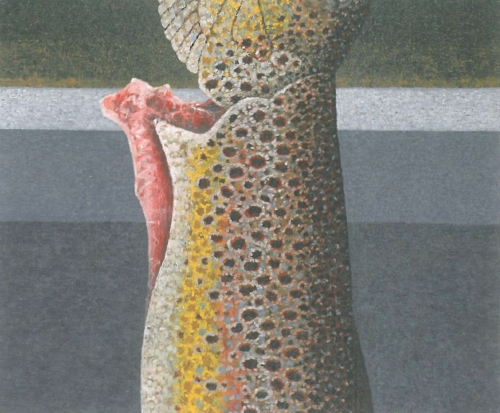
An exhibition of 22 international screen works did critical justice to an exploration of issues around fictionalised or manufactured consensus, investigating how the media manipulates public opinion. The ubiquity of surveillance and the shaky ground that dissent now occupies were subtexts of this project by curator Mike Stubbs, ACMI's exhibitions manager, recently arrived from the UK.
Inside the entrance of the screen galleries The Institute for Applied Autonomy, a collective from the US, exhibited software that provides maps of cities showing surveillance-free routes. This was apparently used by activists during the recent Republican conference in New York City. iSee (2001) shows a healthy resistance to the totalising impulses of an authority complex that wants to capture citizens on electronic surveillance whether 'misbehaving' or not, and comments on the diminishing accessibility of public space for free expression. This work comprises a strategy of withdrawal reminiscent of the Situationists.
Further into the exhibition a short colour film by Nizar Jabour Greetings from Iraq showed day-to-day, normal life with family groups and children in domestic settings. Some particularly beautiful scenes were filmed from a moving vehicle, passing palm forests and black-burkha-clad figures walking in groups along the roadside. Seeing these peaceful, enigmatic images of Iraq, away from war zones, gave another perspective, a badly-needed other glimpse.
As Guattari mentions in The Three Ecologies, the presentation of more singular views and the cultivation of these is vitally important in this age where not only environmental and social ecologies are being eroded, but the mental diversities of individuals are also under threat. Jem Cohen's Chain Times Three (2002) narrates a universal mall-culture blanking out regional identities. The kind of generic thinking encouraged by consumption of TV and newspapers is similar. Jay Rosenblatt's film cycle of dictators, Human Remains (1999) uses an infotainment/documentary style to blur genres and evade corporate sound bites.
In this exhibition of contemporary relevance and intellectual engagement the curator seems to be foregrounding the moving image as a vector of alternative communication which has enormous potential for toward social change. The seductive form, the aesthetic potential of film/video as compositional medium, can carry complex content easily.
Another American artists' collective in the exhibition, Critical Art Ensemble (CAE) makes work that blends critical theory, technology and political activism. The story of one of the co-founders, Steve Kurtz, arrested by the FBI, has been buzzing on independent media websites for months. Under suspicion of bioterrorism due to some harmless biological samples found at his home, his flat was taken over for four days by the FBI and CAE's film, made during the aftermath, documents the detritus of a witch-hunt, a new McCarthyism. Kurtz, a professor, has an excellent essay in the catalogue accompanying this exhibition, and while he awaits trial, support and disbelief continue to grow.
A two hour public forum accompanied the exhibition, where public figures, artists and academics debated what constitutes proof in this age, where consensus-reality is preceded by images in the mass media. QC Julian Burnside observed of the forum that artists were the ones asking the most interesting questions, and it is worth noting that the curator is also a prolific filmmaker and media art producer who had a retrospective of his videos shown at Tate Britain in 1999.
The fusion of art, politics and media in the exhibition and the rigorous catalogue essays, together with the idea of a public forum, show him to be an effective communicator who has an ethical drive towards these investigations into the weaponising of the image, the abstraction of the real by image and word technologies. With artists giving websites and email addresses in the catalogue there is a feeling of access.
Many of the artists use re-purposed media fragments and it is interesting to note precursors in the experimental short films of the sixties, William S. Burroughs' recorded collages and the text cut-ups of Brion Gysin. Both Burroughs and Guy Debord were sixties prophets of this media-saturated age. They spoke of an avalanche of one-way communication used for social control via the fabrication of public opinion.












